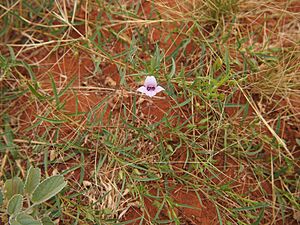Eremophila hughesii facts for kids
Quick facts for kids Eremophila hughesii |
|
|---|---|
 |
|
| Eremophila hughesii in Maranoa Gardens, Melbourne | |
| Scientific classification | |
| Genus: |
Eremophila (plant)
|
| Species: |
hughesii
|
| Synonyms | |
|
|
Eremophila hughesii is a type of flowering plant. It belongs to the figwort family. This plant is special because it grows naturally only in Australia. It is a tall, thin bush with smooth, narrow leaves. Its flowers can be blue, pink, or sometimes white. You can find it growing in Western Australia and the Northern Territory.
Contents
What Eremophila hughesii Looks Like
Eremophila hughesii is an open, sprawling bush. It can grow from about 0.9 to 3 meters (3 to 10 feet) tall. Its thin branches are covered with a sticky, reddish-brown sap called resin.
The leaves grow one after another along the branches. They are often spread out. Each leaf is usually 20 to 50 millimeters (0.8 to 2 inches) long. They are very narrow, about 0.7 to 1.8 millimeters (0.03 to 0.07 inches) wide. Sometimes, they have tiny teeth near their tips.
Flowers and Fruits
The flowers grow one by one where the leaves meet the stem. Each flower sits on a short, hairy stalk. There are five green to purple parts called sepals. These are shaped like eggs or spears and are 6 to 9.5 millimeters (0.2 to 0.4 inches) long.
The petals are 18 to 28 millimeters (0.7 to 1.1 inches) long. They join together at the bottom to form a tube. This tube is usually white to light purple. The top part is often a darker purple. Inside, it's creamy or yellowish with purple spots.
The outside of the flower tube and its petal tips are hairy. But the inside of the petal tips is smooth. The inside of the tube is fuzzy like wool. There are four stamens (the parts that make pollen) hidden inside the petal tube.
This plant flowers from April to November. After flowering, it produces dry, woody fruits. These fruits are oval-shaped and have a papery covering. They are about 6 to 7 millimeters (0.2 to 0.3 inches) long.
Plant Name and History
The name Eremophila hughesii was first officially written down in 1874. This was done by Ferdinand von Mueller. He was a government botanist in Victoria, Australia. He described the plant using samples collected during an expedition by Ernest Giles.
The second part of the plant's name, hughesii, honors Sir Walter Hughes. He was the person who started the University of Adelaide.
Different Types of Eremophila hughesii
Scientists recognize two main types, or subspecies, of Eremophila hughesii:
- Eremophila hughesii subsp. hughesii: This type grows from Laverton in Western Australia all the way to the western edge of the Northern Territory. You can find it in areas like the Gascoyne, Gibson Desert, and Murchison.
- Eremophila hughesii subsp. sanguinensis: This type is found in the western part of Bloods Range in the Northern Territory.
Where Eremophila hughesii Grows
Eremophila hughesii likes to grow in sandy and gravelly soils. You can find it on flat sandy areas or rocky ridges. It often grows in woodlands where mulga trees are common. It also grows in grasslands with spinifex grass.
How Eremophila hughesii is Protected
The Western Australian Government's Department of Parks and Wildlife says that Eremophila hughesii is "not threatened." This means it is not currently in danger of disappearing.
Growing Eremophila hughesii in Gardens
Because this plant tends to be tall and thin, it might not be the first choice for every garden. However, young plants can look quite nice.
You can grow new Eremophila hughesii plants from cuttings. You can also grow them by grafting them onto a Myoporum rootstock. This plant grows best in soil that drains water well. It prefers a sunny spot or a place with some shade. It can handle dry conditions, but it doesn't like frost very much.


